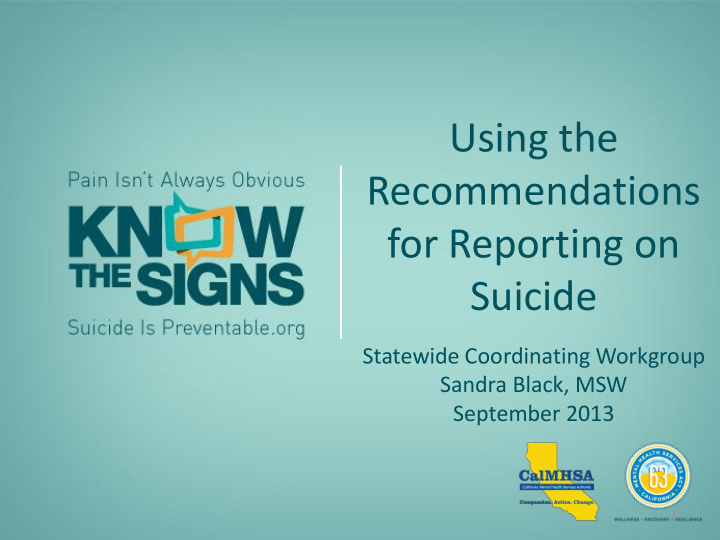



Using the Recommendations for Reporting on Suicide Statewide Coordinating Workgroup Sandra Black, MSW September 2013 Know the Signs >> Find the Words >> Reach Out 1
Why have recommendations? • Sensitivity to survivors • Confidentiality of decedent and families • Contagion – process by which a vulnerable person is influenced towards suicidal behavior through knowledge of another person ’ s suicidal act. – What makes suicide unique in reporting Know the Signs >> Find the Words >> Reach Out 2
Suicide by Readers or Viewers May Increase When: • The number of stories about individual suicides increases. • A particular death is reported at length or in many stories. • The story of an individual death by suicide is on the front page or at the beginning of a broadcast. • The headlines about specific suicide deaths are dramatic. A real example: "Boy, 10, Kills Himself Over Poor Grades". Know the Signs >> Find the Words >> Reach Out 3
How the Recommendations were developed History – 1987: Suicide cluster in New Jersey – 1988: MMWR article and CDC plan for clusters – 2001: Meeting CDC Paper 2001 – 2001: AFSP “black version” – 2005: SPRC 2- page “at -a- glance version” – 2006: SPRC safe messaging guidelines – 2011: New consensus version of recommendations for the media Know the Signs >> Find the Words >> Reach Out 4
2011 Consensus Recommendations Know the Signs >> Find the Words >> Reach Out 5
www.ReportingonSuicide.org Know the Signs >> Find the Words >> Reach Out 6
Sensational Media Coverage Media icon Highly glamorized Sensational death Massive coverage 12% increase in suicides across US in 30 days after death Equivalent of approximately 200 people* *American Psychiatric Association on September 21, 2001 (Volume 36 Number 18). Know the Signs >> Find the Words >> Reach Out 7
DO inform without using sensational terms – Examples: “skyrocketing rates” of suicide or “suicide epidemic” – Misleading depiction of suicide in the community What can you do in an interview and in messaging? • Use objective language • Maintain a hopeful tone • Use reliable data to describe suicide Know the Signs >> Find the Words >> Reach Out 8
DO communicate that suicide is complex • Linking suicide with a single cause or event oversimplifies the complexity of suicide – E.g. Imagine the headline: “Job loss causes man to die of heart attack” What can you do in an interview and in messaging? • Avoid mentioning only one preceding event, if that is the only piece of information available • Make a broad statement of the complexity of suicide Know the Signs >> Find the Words >> Reach Out 9
Promote prevention • DO offer information on warnings signs – Helps the reporter frame suicide appropriately – Educates the audience on signs to look for What can you do in an interview and in messaging? • Discuss more than one warning sign or risk factor for suicide • Discuss how many risks contribute to suicide • Include information on protective factors Know the Signs >> Find the Words >> Reach Out 10
DO promote a resource – Reach people with suicide prevention – Alerts reporters to resources they may not be aware of What can you do in an interview and in your messaging? • Always have information handy – provide materials for reporters to take home or link to • Provide a description of the resource Know the Signs >> Find the Words >> Reach Out 11
How are we doing? California baseline media analysis – Most news items avoided sensational language – Most newspaper articles and ½ of the broadcasts did not link suicide to a single event or cause – ½ of newspaper articles and ¼ of broadcasts indicated any warning sign or risk factor – ½ of news items provided graphic details about suicide; ¼ gave information about the weapon – Fewer than 10% of news items provided a resource Know the Signs >> Find the Words >> Reach Out 12
Challenges in using the Recommendations • We need to first adopt them into our own messaging • They may be seen as having too many “don’ts” and not enough “ do ’ s ” • Reporting policies and styles might pose barriers to their implementation • Need for an ongoing relationship with the media to encourage their use Know the Signs >> Find the Words >> Reach Out 13
Let’s keep our messages clear… Know the Signs >> Find the Words >> Reach Out 14
Using the message triangle Know the Signs >> Find the Words >> Reach Out 15
Media outreach and advocacy • Establish ongoing, mutual relationship with media – be a “go to” resource • Develop key messages for your target audiences • Engage as partners the people the media go to for information • Be ready: Develop news angles, story ideas, and “proactive responses” Know the Signs >> Find the Words >> Reach Out 16
Available for free download from www.Your.VoiceCounts.org Know the Signs >> Find the Words >> Reach Out 17
Handling Memorial Services and Public Observances Know the Signs >> Find the Words >> Reach Out 18
Reaching seniors Know the Signs >> Find the Words >> Reach Out 19
Guide for funeral directors Know the Signs >> Find the Words >> Reach Out 20
Peer support for survivors of suicide loss Know the Signs >> Find the Words >> Reach Out 21
All-inclusive School Toolkit Know the Signs >> Find the Words >> Reach Out 22
Website for crisis preparation and response Know the Signs >> Find the Words >> Reach Out 23
Thank you for participating!* THANK YOU! Anara Guard, MLS Education Development Center Sandra Black, MSW aguard@edc.org sblack@edc.org Theresa Ly, MPH Education Development Center tly@edc.org Know the Signs >> Find the Words >> Reach Out * don’t forget to fill out the evaluations ! 24
Recommend
More recommend